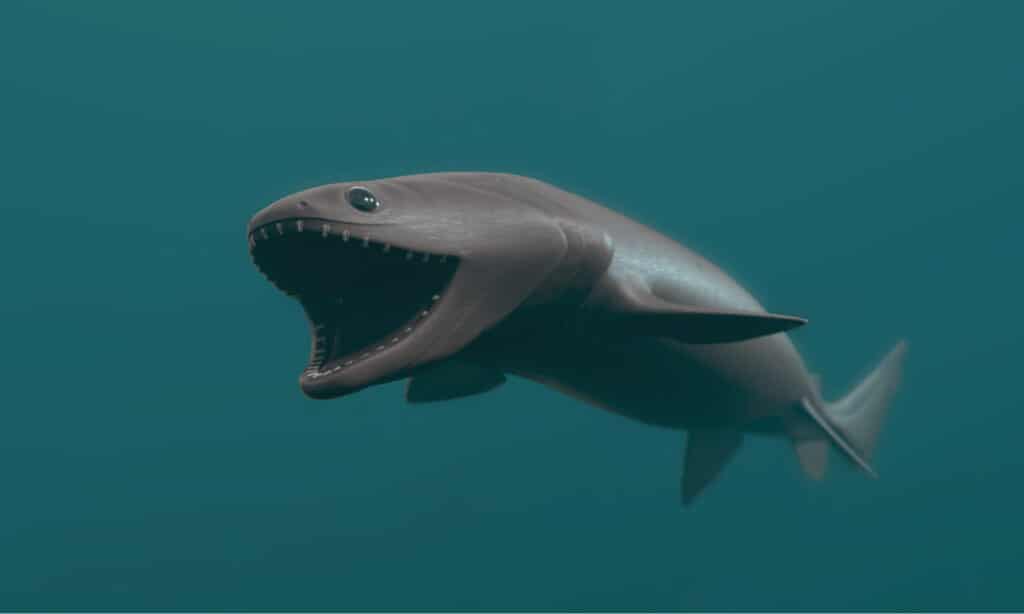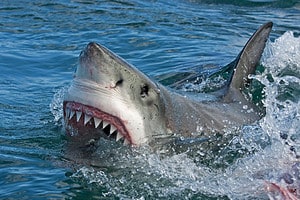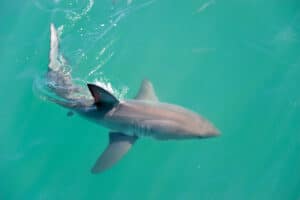The ocean is home to several frightening and fascinating creatures, and the frilled shark is one of those creatures that tick the box of these two qualities — they’re both frightening and fascinating. Everything about this prehistoric “sea serpent”, from their appearance to how they feed and reproduce, is a wonder to scientists. The eel-like frilled shark is rarely seen by humans, so it’s always big news whenever they pop up on the radar. Here are some incredible frilled shark facts you’ve probably never heard before.

This 3D rendered image of a Frilled Shark shows the unique tooth pattern of this species of shark.
©iStock.com/3dsam79
10 INCREDIBLE FRILLED SHARK FACTS
What’s In A Name?
The scientific name of the frilled shark is Chlamydoselachus anguineus. However, their common name is a pointer to one of their most bizarre qualities. Unlike other shark species that are known to have separate grills on either side of their body, the frilled shark’s first pair of grills go all the way across its body. Even more interesting, each pair is lined with a red fringe at the edges. The six gills form a frill around their neck, which is why they’re called frilled sharks. A little on the nose, but it works.
They Only Get Together To Mate
Frilled sharks live mostly solitary lives. The only time male and females get together (as far as we know) is when it’s time to mate. Scientists think their mating behavior is not as far off from that of many other shark species. Unlike many other fishes, fertilization is internal for many sharks, and that’s true for the frilled sharks, too. Once the pups are born, parents don’t seem to care for them, which means most frilled sharks live alone for the most part.
Probably The Most Intense Dentition You’ll Ever See
Sharks are known to have terrifying dentition, or teeth arrangement, but frilled sharks take it to a whole new level. Although they don’t have as much bite force as the big dogs like the great white shark, their jaws are lined with 300 trident-shaped teeth, arranged in 25 backward-facing rows in their mouth. This arrangement makes their jaw specially adapted for grasping and holding prey. With their velcro-like teeth, it’s unlikely that any prey unlucky enough to get caught in their mouth would ever escape. As if the rows of freaky teeth were not enough, frilled sharks also have rows of spines called denticles on the dorsal margin of the caudal fin, which means touching them is a bad idea too.
It May Strike At Prey Like A Snake
This is more of a postulation because no one has observed the frilled shark hunting. However, scientists believe the frilled shark can launch itself at prey using its posterior fins for propulsion. This shark also has long jaws hinged at the back of its head, allowing it to gape extra wide like a snake. This makes it possible for the frilled shark to take prey that is half as long as its own body length. Studies have revealed that their diet consists predominantly of cephalopods but may also feed on teleost fish and other sharks.
They’re Everywhere, But Your Chances Of Seeing One Is Rare
According to the United Nations Food and Agriculture Organization, frilled sharks are found all over the world. However, they’re so spottily distributed that your chances of encountering them are slim. In addition to their sparse distribution, another factor that makes it less likely to find these sharks is that they are found at depths of between 390 and 4200 feet. They rarely venture to the surface. Most times, when humans find them, it’s either because it was caught accidentally as bycatch or found floating sick, lost, or already dead in the water.
Frilled Sharks Exhibit Sexual Dimorphism
Frilled sharks exhibit sexual dimorphism. The female frilled sharks are typically larger than the males. This isn’t all that surprising since they’re not the only type of shark known to exhibit this behavior. The average size of the males is usually between 3.2 to 3.6 feet, while males are typically 4.4 to 4.9 feet in length. The maximum size of frilled sharks is about 6.4 feet.
Abnormally Long Gestation Period
Here’s another frilled shark fact — they have the longest gestation of all living vertebrates. Their gestation period may be as long as 3.5 years. They breed all year round and produce through a method of reproduction known as aplacental viviparity. This means their young are born alive from the mother’s uterus, but they do not take nourishment from her like mammals. Instead, they’re contained in egg capsules and feed on yolk until they’re born. The gestation period of the frilled shark is nearly twice as long as that of the African elephant. Scientists are unsure why they carry their young for so long, but some theories suggest that it might have something to do with the cold deep-sea habitat.
Probably Doing Okay
Not much is known about the frilled shark’s habits or even how many of them we have in the seas at the moment. For a while, they were thought to be endangered, but we simply don’t have enough data to reach any conclusion. They were once listed as “near threatened” by the International Union for the Conservation of Nature (IUCN) due to their extremely slow rate of reproduction. Today, the IUCN considers them of “least concern”, which means they’re probably doing okay, but there’s no way to tell for sure. We do know that they’re pretty resilient. For a species that has been around for millions of years, living in the cold depths of the ocean, the odds seem to be in their favor.
Camera Shy
Frilled sharks were first discovered as far back as the 1800s. Thus, it is surprising that we do not know enough about them even till now. The first time the species was observed in their natural habitat was in 2004, about 200 years after they were first described – and even that was an accidental occurrence. A deep-sea research team sighted one off the Southeastern coast of the United States and caught it on Camera.
Encounters with humans are rare. Sometimes, deepwater commercial fisheries may catch the shark in trawls or longline fisheries by accident. However, they’re generally hard to get hold of as they tend to damage nets and escape. Grilled sharks are not aggressive, but they are weaponized enough to be dangerous to humans when handled improperly.
Living Fossils
Scientists call frilled sharks “living fossils” because they’ve been around for so long. They have been here for more than 80 million years. Interestingly, they have not changed a lot in terms of their appearance and habits. Scientists think they used to live in shallower waters before the mass extinction that wiped out most of the dinosaurs but had to adapt by moving into deeper water in search of prey.
Up Next
- Discover the River Monster Fish with Teeth the Size of a Great White Shark! Have you ever heard of the fish with teeth approximately the same size as those of a great white shark? Read all about this river monster fish.
- Pyjama Shark– This strange-looking shark that lives off the coast of South Africa has to be on the list of bizarre-looking sharks. Read all about it here.
- 10 Incredible Great White Shark Facts – If there’s a shark everyone seems familiar with, it has to be the Great white. Here are 10 interesting facts you probably didn’t know about them.
The photo featured at the top of this post is © OpenCage / CC BY-SA 2.5 – License / Original
Sources
- Shark Guardian / Accessed July 19, 2022
- Animal Spot / Accessed July 19, 2022
- Mental Floss / Accessed July 19, 2022
- Wikipedia / Accessed July 19, 2022
Thank you for reading! Have some feedback for us? Contact the AZ Animals editorial team.







